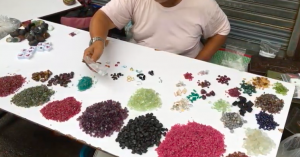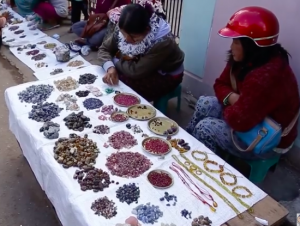Gemstones deposits in the world

Gemstones formed by geological processes in the rocks of the earth’s crust and upper mantle. The rocks and gemstones we find nowadays on the surface of the earth were buried for a long time (millions of years) deep in the earth’s crust and mantle, where conditions (temperature and pressure) enabled a formation and transformation of gemstones and rocks. If due to erosion a rock formerly buried is brought to earth’s surface, we might find within this rock gem materials and ores (e.g. gold). Gemstones form and can be found in three different geological environments:
-Magmatic and volcanic rocks
-Metamorphic rocks
-Sedimentary rocks
Primary Gemstone Deposits
The gemstones are found in their original host-rock. The profitability of such a deposit is highly dependent from the concentration of gemstones (per ton of rock) and the weathering stage of the host-rock. A lot of large-scale diamond mining operations work primary kimberlite deposits in the search for diamonds. Many primary colored gemstone mining sites are found in decomposed pegmatite veins (e.g. for topaz, beryl etc.). Certain gemstones such as emeralds are nearly exclusively found in gem-quality in primary deposits.

Secondary Gemstone Deposits
When a primary gemstones deposit is weathered or eroded, more durable gemstones such as diamond, corundum and chrysoberyl may be transported by water or wind energy and accumulated later in a secondary gravel deposit (sedimentary regime), e.g. along a river or in a delta. Such rich concentrations of dense rough gemstones are often called gem pockets. They are a great source of gemstones in many deposits in Sri Lanka, Madagascar, Tanzania and others region.

Significant gemstone deposits have been discovered, explored, and often depleted across the globe. A significant portion of gem mining is artisanal, done by hand without a huge environmental impact. In open pit mining, huge amounts of surrounding rock are relocated. Alluvial mining is the most archaic form of mining and is still practiced today. Alluvial deposits occur when mineral deposits are transported by water and settle into the sediment. Here is a brief list of geographical locales famous for their gemstone mines;
Mozambique, Kenya and Tanzania are famous discoveries of ruby, sapphire, alexandrite, tourmaline, garnet, alexandrite, aquamarine, rhodolite. Mozambique has famous for high quality ruby and Paraiba tourmaline. Tanzania is especially famous for tanzanite. Kenya is especially famous for Tsavorite garnet in Tsavo National Park.
Nigeria, the large western African and highly regarded for the blue sapphire as well as large quantities of fine tourmaline. Niegria is alow well known for almandine garnet, aquamarine and topaz.
Madagascar is a very large island, located in the Indian Ocean of the Southeast coast of Africa. The discovery of significant gem deposits a wide range of gemstones have been discovered not only sapphire and ruby, it’s also has alexandrite, emerald, chrysoberyl, tourmaline, aquamarine, topaz, garnet, zircon, amethyst…
Nigeria has large quantities of fine tourmaline and highly regarded for blue sapphire also well known for Almandine garnet, topaz and aquamarine.
Tanzania is particularly well known for Tanzanite. Tanzanian spinels from Mahenge have been in the spotlight. It’s color can rival the most beautiful rubies and have steadily increasing in popularity. For other gemstones from Tanzania include garnet (Tsavorite and Rhodolite.
Zambia The Kamakanga emerald mine has reopened and is producing emerald of all grades. The mine was not in full operation for the last seven years. The other emerald mines in Zambia have reduced production considerably. Production of high quality amethyst in two localities has increased. Commercial quality aquamarine and pyrope garnet continue to be produced in considerable quantities in the Lundaze area. There is a new find of dentritic opal, yellow transparent to translucent common opal with tree-like dendrite forms of manganese oxide psilomelane, in southeastern Zambia, 40 km northest of Maamba near Lake Kari.

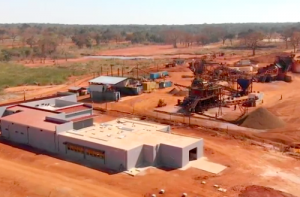
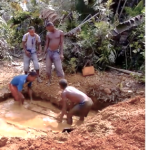
Brazil produces the greatest variety of gems and semi-precious stones in the world, including diamonds, emeralds and amethyst. Mining is very much a part of the Brazilian culture and prospecting is a way of life for many people. If a mineral deposit is found in an area where no exploration license has been granted then prospectors, called garimpeiros, can mine the area using manual tools to extract the minerals. Of course many of the mines in Brazil are modern operations, owned by mining companies, similar to Canada. Some of the most spectacular gems come from the region near the city of Belo Horizonte, in the state of Minas Gerais. This area produces emerald, aquamarine, rubellite (pink tourmaline), green tourmaline, imperial topaz, alexandrite and amazonite. These gems are commonly associated with pegmatites and several of these deposits were the subject of a field trip sponsored by the 31st International Geological Congress in 2001. This article will first provide some background on the origin of pegmatites, then look at some specific deposits and how they came to contain gems.
Colombia is the source of the world’s finest emeralds and accounts for the 50% of the value supplied in the market. The Colombian emerald deposits are located in Boyacá Department and are found in the Eastern Ranges of the Colombian Andes within two narrow bands on the west side (western zone: Muzo, Cunas, and Coscuez deposits) and on the east side (eastern zone: Chivor and Gachalá deposits).
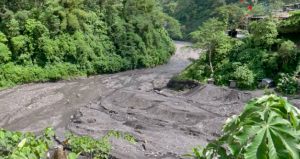
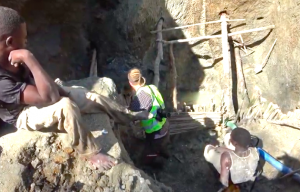

Myanmar is fortunate in containing world-class gem deposits, such as the finest pigeon’s-blood-coloured ruby from the Mogok Stone Tract in Mandalay Division, the Mong Hsu ruby deposit in Shan State and imperial coloured jadeite jade from Kachin State. For the purposes of description the gemstone deposits in Myanmar are classified into: (1) primary hard-rock deposits in which the gemstones are hosted in the rocks in which they were crystallized or in their weathered products; and (2) secondary deposits in which the gemstones have been weathered out of their original (primary) host rock, transported and deposited as placer deposits in alluvial sediments. Examples of the primary-type gems are ruby in marble (Mogok, Mong Hsu and Sagyin), sapphire in syenite pegmatite, syenite and nepheline syenite (Mogok) and jadeite in serpentinized peridotite (Tawmaw). Other precious gemstones from primary deposits include spinel in marble (Mogok), peridot in dunite/peridotite (Mogok), topaz, aquamarine, tourmaline, quartz, etc. in pegmatite (Mogok, Mong Hsu and Momeik) and kyanite in quartzite (Moehnyin). Rare gemstones are often found in primary gem deposits in the Mogok Stone Tract and include johachidolite and hackmanite from pegmatites, painite from leucogranite and skarn, pollucite, petalite, phenakite, pezzottaite, monazite, danburite, jeremejevite and hambergite from pegmatites in the Momeik area.
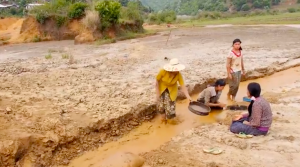

Sri Lanka All varieties of Corundum are found in Sri Lanka including the “PADPARADSCHA” which is unique to the island. Ratnapura: The oldest known source in Sri Lanka, meaning “City of Rubies” or “City of Gems”. Elehara District: important in recent years for producing large and fine specimens of many gems, including Sapphire and Cat’s Eye Chrysoberyl. The area around Morawaka: known for Alexandrite and Cat’s Eye Chrysoberyl. Mining in Sri Lanka is mainly alluvial with gem deposits found not only in present river systems but also below rice paddies where ancient rivers once flowed. The depth of the gem gravel or “ILLAM” varies from 3m to 20m to as much as 40m at Pelmadulla. The search for gems is a highly speculative operation and is usually carried out by a group of native workmen on a share basis. 1/5th goes to the owner of the land, 1/5th to the financier and the rest goes to the workers. Access to these gem producing areas is often limited, especially during the monsoon seasons.

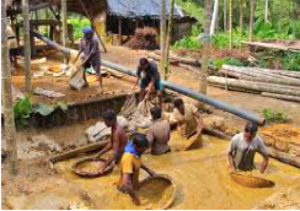

Thailand A number of mineral deposits have been found in Thailand. Gemstones (sapphire and ruby) were derived from Cenozoic basic volcanic. Besides, spinal, quartz, chalcedony, tektite and petrified woods are also important as precious stone. The well-known productive areas of gems in Thailand are Chantaburi and Trat provinces in eastern region. Others are Kanchanaburi in the west, Phrae and Chiang Rai in the north as well as Sri Saket and Ubon Ratchathani in the northeast. Khao Ploi Waen: thought to be the first place in Thailand, where Corundum was found. Bang Kha Cha Gems Found: Blue, green, yellow and black star Sapphires Bo Na Wong and Wat Tok Phrom: Ruby only. Considered to be Thailand’s major source of Blue Sapphires. It was discovered in 1919 and also produces the occasional yellow, pink and star Sapphires. The Blue Sapphires strongly resemble the heat-treated blue sapphires from Sri Lanka. Most are sold in parcels of Sri Lankan goods because of the preference for Sri Lankan blue sapphires.
Gemstone market in Thailand and Myanmar
